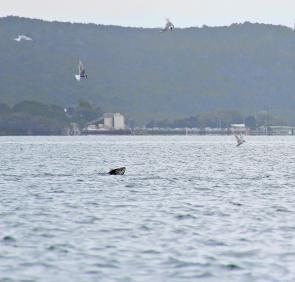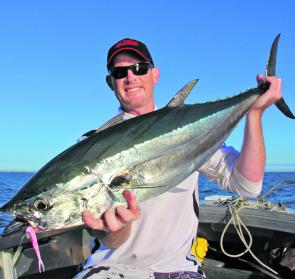The bay has cleaned up nicely and the weather has finally allowed us to get out and amongst the fish on a more regular basis. At this time of year southern Moreton Bay offers plenty of options, with anything from mac and longtail tuna to winter whiting, snapper, bream and the start of the flathead run.
The sand crabs have been on the move with some good numbers coming anywhere from Wellington Point down to Coochie. When targeting crabs remember that you are only allowed four crab pots per person and dillies are no longer legal.
When setting your pots on the first run it pays to place them at varying depths, from shallow (only 1-2m) out into the deeper water (down to 10-12m) if there is water to that depth where you are setting them. After an hour or so, it pays to go check the pots this will allow you to see at what depths the crabs are running. Then you can set your pots accordingly.
You always want the entries of your pots to be facing in the direction of the tides. Crabs will always walk sideways with the tide so having your pots set correctly will definitely increase your catch rate. Make sure you always have your name and address on your float as well as on a tag on the pot itself.
The fishing around the reefs should really fire this month. There is so much bait getting around the bay. It's not just on the surface being terrorised by tuna but it is all around the reef edges as well, which are being terrorised by snapper/mulloway and other reef species. With the bait being up along the reef edges there is the chance that one of those tuna will latch onto your plastics, so be prepared to chase the fish before he spools you.
There has already been great numbers of tuna in the bay, with some quite large longtails in amongst them. Through the end of March to Early April we were getting them as far south as Peel, which is extremely early to have them that far south but you won't see us complaining. These are a great fish to target with new fishos. If you can cast and get hooked up for them then it is their job to land the fish. With the blistering runs and raw power of a longtail they will be hooked on fishing and the memory will last with them for a lifetime.
With the amount of boats on Moreton Bay these days targeting tuna is a game of patience. It’s not all about getting to that school of fish as fast as you can before they stop feeding. It is about positioning your boat right so you can get within casting distance and once you knock the boat out of gear the wind or tide will continue to push you towards the feeding school of fish. So many people make that mistake of roaring up to the school of fish, driving into the middle of them and then casting. You won't consistently catch tuna that way. You might luck out once in a blue moon but it won't happen very often, plus you wreck it for everyone else. Also doing this to one school a couple of times and the tuna will go down and stay down.
There has been good numbers of small snapper getting around the bay islands at the moment as well; with some solid fish coming from the shallows. It’s not surprising considering all the bait that is around. When I am going for a fish around the islands, yes I have my go-to spots, but if there is no bait on then I will begin to move abroad in search of it.
An electric motor can come into its own when searching for bait. You are able to creep your way along a drop-off, not making a sound except for the water hitting the bottom of the boat and search for bait as you are casting. By doing this you can also land your plastic in front of a few roaming fish that are hanging around on their own.
As soon as you find the bait, you will find the schooled up fish hanging around. Knowing how to read your sounder properly is paramount. It will increase you catch rate but will also minimise your time searching for fish.
I hope that the weather and the fish are kind to us once again this month. I’m sure looking forward to getting out there and smashing a few fish.
1
This solid juvenile snapper is the result of targeting bait schools. It may take a little more effort but will definitely be worth it in the end. The Dobyns Champion Extreme 743 is a great rod for working the drop-offs because of its casting ability.
2
Seeing tuna clear the water like this is a sure sign that they are a school of longtails. Mac tuna tend to make the water look like it’s boiling.
3
Being patient in following a school of tuna will result in a great fish, like this one landed by Gordon Irving. Stealth is the key.
4
When you've found a good bait ball on a drop-off, casting hardbodies is a fun and rewarding way to target the snapper too, like this one taken on a Maria MJ-90 Jerk Bait.
Reads: 1388







